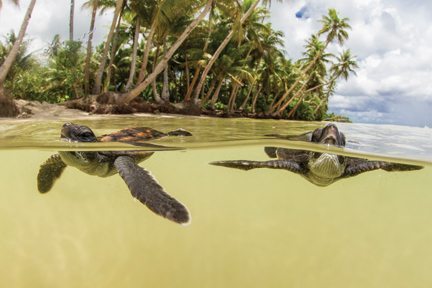One of the more compelling types of images that underwater photographers create is known as a split. Captured by positioning the lens at the water’s surface so that some of the lens is recording the scene below the surface and the rest is capturing the topside scene, splits require some parameters to attain success. You need (1) an approachable subject that is of the right size, (2) flat seas, (3) the opportunity to compose a shot so you are not shooting directly into the sun, (4) enough light to get a proper exposure while using a small aperture, and (5) the right equipment.
Splits are challenging, and a lot of things need to work in your favor. But create a nice split, and you have an image that is both compelling and memorable.
So let’s delve into the equipment, factors and techniques necessary to create a memorable split image.
As a rule, splits are best created when using a single-lens reflex camera with an extreme wide-angle lens mounted behind a dome port. With the corresponding extreme angle-of-view, you need a relatively large subject so your subject can fill a pleasing percentage of your frame. Or you need to get within a few inches of subjects as small as the baby turtles seen in the split image shown here.
It is helpful to keep drops of water off the dome port to avoid degrading your image with distracting droplets. This is much easier to do on days when the surface is flat and the wind is calm, and impossible in bumpy seas. Applying baby shampoo on a glass port and giving it a quick rinse just before you compose your shot will help cause unwanted droplets to run off a dome port.
Avoid shooting toward an unblocked sun, because it will likely cause you to blow out the topside portion of your shot, or make the below-water portion so dark that it is unusable.
Focusing a lens behind a dome port is tricky. The underwater portion of the lens actually focuses on what is known as the virtual image as the dome becomes part of the optical system when submerged. The lens has to be able to focus on the underwater foreground subject while also having topside elements in the distance acceptably focused. To properly execute this technique, focus the lens on the underwater foreground subject while using a small aperture such as f-16 or f-22. This will give you enough depth-of-field for the distant elements in the topside part of the scene to be within the bounds of acceptable focus.
Lastly, you need to properly expose the brightest parts of the shot (probably the topside scene) so that you can “hold the highlights” and then use software such as Photoshop to increase the exposure of the underwater scene if need be. Working over a shallow bottom that reflects a lot of sunlight can help with the underwater exposure, and so can the use of a strobe if it is necessary.




